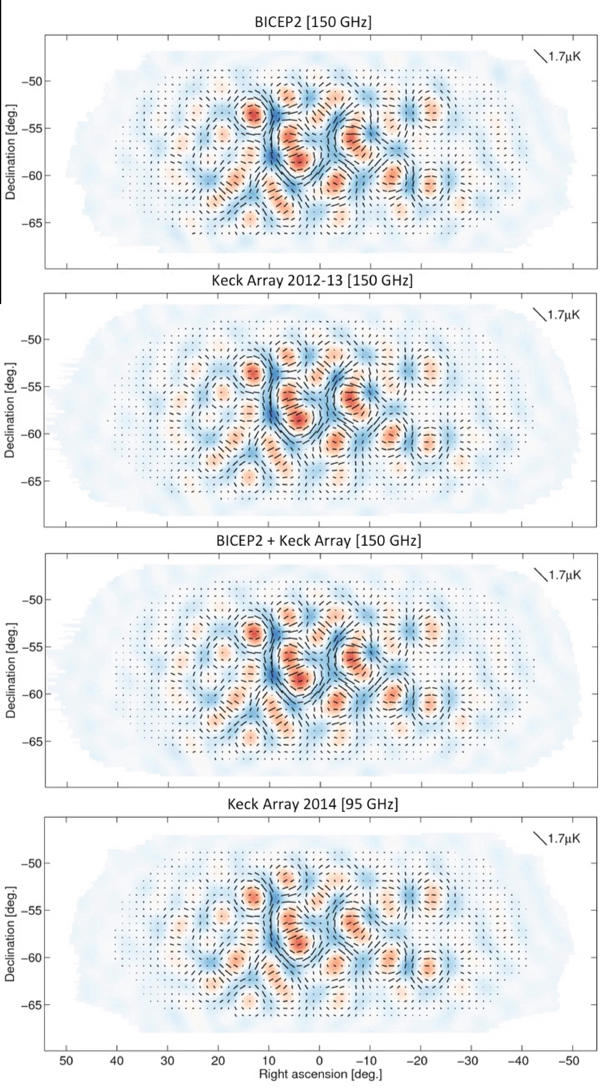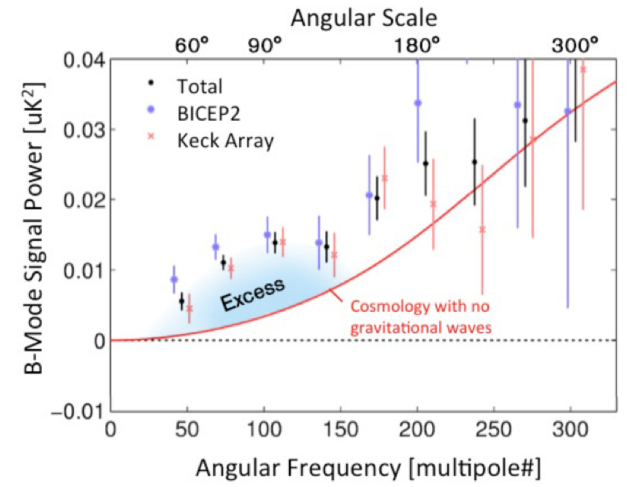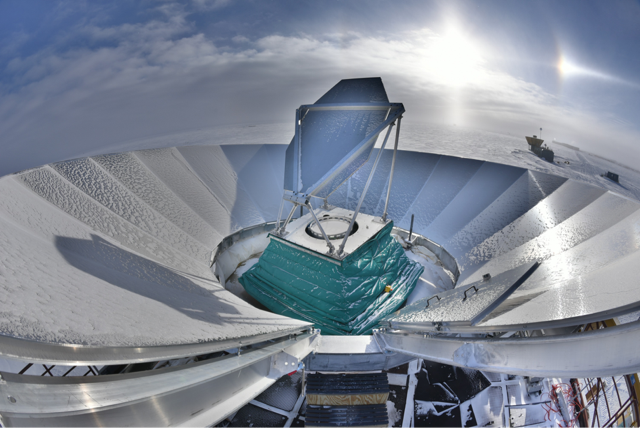 If you’re reading this you probably know about the BICEP2 experiment, a radio telescope at the South Pole that measured a particular polarization signal known as “B-modes” in the cosmic microwaves background radiation. Cosmologists were very excited at the prospect that the B-modes were the imprint of gravitational waves originating from a period of inflation in the primordial universe; now, with more data from the Planck satellite, it seems plausible that the signal is mostly due to dust in our own galaxy. The measurements that the team reported were completely on-target, but our interpretation of them has changed — we’re still looking for direct evidence for or against inflation.
If you’re reading this you probably know about the BICEP2 experiment, a radio telescope at the South Pole that measured a particular polarization signal known as “B-modes” in the cosmic microwaves background radiation. Cosmologists were very excited at the prospect that the B-modes were the imprint of gravitational waves originating from a period of inflation in the primordial universe; now, with more data from the Planck satellite, it seems plausible that the signal is mostly due to dust in our own galaxy. The measurements that the team reported were completely on-target, but our interpretation of them has changed — we’re still looking for direct evidence for or against inflation.
Here I’m very happy to publish an interview that was carried out with Jamie Bock, a professor of physics at Caltech and a senior research scientist at JPL, who is one of the leaders of the BICEP2 collaboration. It’s a unique look inside the workings of an incredibly challenging scientific effort.
New Results from BICEP2: An Interview with Jamie Bock
What does the new data from Planck tell you? What do you know now?
A scientific race has been under way for more than a decade among a dozen or so experiments trying to measure B-mode polarization, a telltale signature of gravitational waves produced from the time of inflation. Last March, BICEP2 reported a B-mode polarization signal, a twisty polarization pattern measured in a small patch of sky. The amplitude of the signal we measured was surprisingly large, exceeding what we expected for galactic emission. This implied we were seeing a large gravitational wave signal from inflation.
We ruled out galactic synchrotron emission, which comes from electrons spiraling in the magnetic field of the galaxy, using low-frequency data from the WMAP [Wilkinson Microwave Anisotropy Probe] satellite. But there were no data available on polarized galactic dust emission, and we had to use models. These models weren’t starting from zero; they were built on well-known maps of unpolarized dust emission, and, by and large, they predicted that polarized dust emission was a minor constituent of the total signal.
Obviously, the answer here is of great importance for cosmology, and we have always wanted a direct test of galactic emission using data in the same piece of sky so that we can test how much of the BICEP2 signal is cosmological, representing gravitational waves from inflation, and how much is from galactic dust. We did exactly that with galactic synchrotron emission from WMAP because the data were public. But with galactic dust emission, we were stuck, so we initiated a collaboration with the Planck satellite team to estimate and subtract polarized dust emission. Planck has the world’s best data on polarized emission from galactic dust, measured over the entire sky in multiple spectral bands. However, the polarized dust maps were only recently released.
On the other side, BICEP2 gives us the highest-sensitivity data available at 150 GHz to measure the CMB. Interestingly, the two measurements are stronger in combination. We get a big boost in sensitivity by putting them together. Also, the detectors for both projects were designed, built, and tested at Caltech and JPL, so I had a personal interest in seeing that these projects worked together. I’m glad to say the teams worked efficiently and harmoniously together.
What we found is that when we subtract the galaxy, we just see noise; no signal from the CMB is detectable. Formally we can say at least 40 percent of the total BICEP2 signal is dust and less than 60 percent is from inflation.
How do these new data shape your next steps in exploring the earliest moments of the universe?
It is the best we can do right now, but unfortunately the result with Planck is not a very strong test of a possible gravitational wave signal. This is because the process of subtracting galactic emission effectively adds more noise into the analysis, and that noise limits our conclusions. While the inflationary signal is less than 60 percent of the total, that is not terribly informative, leaving many open questions. For example, it is quite possible that the noise prevents us from seeing part of the signal that is cosmological. It is also possible that all of the BICEP2 signal comes from the galaxy. Unfortunately, we cannot say more because the data are simply not precise enough. Our ability to measure polarized galactic dust emission in particular is frustratingly limited.

‘E-mode’ polarization pattern, a signal from density variations in the CMB, not gravitational
waves. The polarization is given by the length and direction of the lines, with a coloring to better
show the sign and amplitude of the E-mode signal. The tapering toward the edges of the map is
a result of how the instruments observed this region of sky. While the E-mode pattern is about 6
times brighter than the B-mode signal, it is still quite faint. Tiny variations of only 1 millionth of
a degree kelvin are faithfully reproduced across these multiple measurements at 150 GHz, and in
new Keck data at 95 GHz still under analysis. The very slight color shift visible between 150
and 95 GHz is due to the change in the beam size.
However, there is good news to report. In this analysis, we added new data obtained in 2012–13 from the Keck Array, an instrument with five telescopes and the successor to BICEP2 (see Fig. 1). These data are at the same frequency band as BICEP2—150 GHz—so while they don’t help subtract the galaxy, they do increase the total sensitivity. The Keck Array clearly detects the same signal detected by BICEP2. In fact, every test we can do shows the two are quite consistent, which demonstrates that we are doing these difficult measurements correctly (see Fig. 2). The BICEP2/Keck maps are also the best ever made, with enough sensitivity to detect signals that are a tiny fraction of the total.

In addition, Planck’s measurements over the whole sky show the polarized dust is fairly well behaved. For example, the polarized dust has nearly the same spectrum across the sky, so there is every reason to expect we can measure and remove dust cleanly.
To better subtract the galaxy, we need better data. We aren’t going to get more data from Planck because the mission has finished. The best way is to measure the dust ourselves by adding new spectral bands to our own instruments. We are well along in this process already. We added a second band to the Keck Array last year at 95 GHz and a third band this year at 220 GHz. We just installed the new BICEP3 instrument at 95 GHz at the South Pole (see Fig. 3). BICEP3 is single telescope that will soon be as powerful as all five Keck Array telescopes put together. At 95 GHz, Keck and BICEP3 should surpass BICEP2’s 150 GHz sensitivity by the end of this year, and the two will be a very powerful combination indeed. If we switch the Keck Array entirely over to 220 GHz starting next year, we can get a third band to a similar depth.

Finally, this January the SPIDER balloon experiment, which is also searching the CMB for evidence of inflation, completed its first flight, outfitted with comparable sensitivity at 95 and 150 GHz. Because SPIDER floats above the atmosphere (see Fig. 4), we can also measure the sky on larger spatial scales. This all adds up to make the coming years very exciting.

Why did you make the decision last March to release results? In retrospect, do you regret it?
We knew at the time that any news of a B-mode signal would cause a great stir. We started working on the BICEP2 data in 2010, and our standard for putting out the paper was that we were certain the measurements themselves were correct. It is important to point out that, throughout this episode, our measurements basically have not changed. As I said earlier, the initial BICEP2 measurement agrees with new data from the Keck Array, and both show the same signal. For all we know, the B-mode polarization signal measured by BICEP2 may contain a significant cosmological component—that’s what we need to find out.
The question really is, should we have waited until better data were available on galactic dust? Personally, I think we did the right thing. The field needed to be able to react to our data and test the results independently, as we did in our collaboration with Planck. This process hasn’t ended; it will continue with new data. Also, the searches for inflationary gravitational waves are influenced by these findings, and it is clear that all of the experiments in the field need to focus more resources on measuring the galaxy.
How confident are you that you will ultimately find conclusive evidence for primordial gravitational waves and the signature of cosmic inflation?
I don’t have an opinion about whether or not we will find a gravitational wave signal—that is why we are doing the measurement! But any result is so significant for cosmology that it has to be thoroughly tested by multiple groups. I am confident that the measurements we have made to date are robust, and the new data we need to subtract the galaxy more accurately are starting to pour forth. The immediate path forward is clear: we know how to make these measurements at 150 GHz, and we are already applying the same process to to the new frequencies. Doing the measurements ourselves also means they are uniform so we understand all of the errors, which, in the end, are just as important.
What will it mean for our understanding of the universe if you don’t find the signal?
The goal of this program is to learn how inflation happened. Inflation requires matter-energy with an unusual repulsive property in order to rapidly expand the universe. The physics are almost certainly new and exotic, at energies too high to be accessed with terrestrial particle accelerators. CMB measurements are one of the few ways to get at the inflationary physics, and we need to squeeze them for all they are worth. A gravitational wave signal is very interesting because it tells us about the physical process behind inflation. A detection of the polarization signal at a high level means that the certain models of inflation, perhaps along the lines of the models first developed, are a good explanation.
But here again is the real point: we also learn more about inflation if we can rule out polarization from gravitational waves. No detection at 5 percent or less of the total BICEP2 signal means that inflation is likely more complicated, perhaps involving multiple fields, although there are certainly other possibilities. Either way is a win, and we’ll find out more about what caused the birth of the universe 13.8 billion years ago.
Our team dedicated itself to the pursuit of inflationary polarization 15 years ago fully expecting a long and difficult journey. It is exciting, after all this work, to be at this stage where the polarization data are breaking into new ground, providing more information about gravitational waves than we learned before. The BICEP2 signal was a surprise, and its ultimate resolution is still a work in progress. The data we need to address these questions about inflation are within sight, and whatever the answers are, they are going to be interesting, so stay tuned.
Sorry but they were chasing the headlines, the video of the data being shown to Linde is deeply embarrassing.
I am very impressed with the initial publication of the eurika of the finding regarding the presence of a B-mode or gravitational wave spotted, a unique polarization in that particular part of the universe, only to find out later it is possibly a cosmic dust as reported by the European ‘Planck Satellite’ monitoring and carrying out experiment there by scanning the CMB.
The BICEP 2 science community has ample information on the CMB and is able to differentiate and compare all phenomena taking place there to explain what is really going on in that particular part of our universe rather than speculating early when the claim fails to measure up to laid down process before publishing anything. That I think makes people to think the experiment has fallen short to provide us the correct information.
However, I still have confidence in the abilities of those working everyday on BICEP 2 to bring us the right information to explain what happen after the Big Bang and give hope to those of us who believe in some part of inflation.
The guy gives the impression that he is convinced that inflation took place and he’s just frustrated that they haven’t yet found the data to back it up. As far as I can see, there’s nothing in the interview to suggest that inflation might not have happened at all. He’s working backwards from the answer he wants to find.
And what does he mean by “Formally we can say at least 40 percent of the total BICEP2 signal is dust and less than 60 percent is from inflation.” My understanding of the joint analysis was the entire signal was completely a match for dust. Zero percent is from inflation! This Bicep team …. hmm …
I’m not sure this is such a great episode in science – Planck had huge resources but didn’t employ instruments sensitive enough to say something stronger than >40% of the B-mode signal is from dust, and BICEP made a goof in their technical analysis which claimed B-modes were from gravitational waves.
I’m not sure why the question about regretting the release of the results.
1) As Bock says, a negative result is just as interesting as a positive result.
2) It seems like a bit of a “how much of the swan do you want to see” question. We either want science to be a pristine swan, gliding along delivering perfectly formed, correct results at all times; or we want to look at the dirty underside as well, with the legs kicking away most inelegantly. I (a non-scientist) would like to look at the underside occasionally, and then not kick science in the teeth for letting me see it!
I don’t know how this plays out within the discipline in terms of how much certainty and checking you do before publication, but from the outside it looks like a fairly healthy self-corrective process to me.
When data EBEX?
I think it’s okay if we get an incorrect result in the public time to time as long as the team reacts properly when the error is found.
Out of the two I know, I like the Opera experiment’s blunder more because they never claimed they found new physics or confirmed some exotic theory, they just made it public that their numbers don’t match. I believe no serious scientist expected their result to be right so what we got was a thrilling scientific quest to find the error which was awarded with a success in the end. And I find it exciting how seemingly negligible technical issue can have such extended effects.
Bicep2 was different as its results kind of came along the expectations, not against them. History tells use their celebrations were premature but at the time they held them, they were sure certain they’re right. Overall I agree with Jester’s assessment of the cause. It’s still reassuring to see scientists working meticulously on invalidating their own previous result as soon as an error is found and better data are available. I hope they’ll be awarded by real discovery of the polarization soon, they deserve it.
John at 10:54 March 2: Isn’t the answer to your concerns inherent in science’s insistent on reproducability? When Wilczek et al published on asymptotic freedom, it was followed by decades of thousands of efforts to check and repeat. If your big concern is Bock et al could ’embarrass science’, it’s not a person it’s a process.
Bock gave a talk early on while the criticism on galactic dust was starting (The link I used for it may have come from this website.) As he spoke on background & history, it stuck me he seemed much the true-believer, cheer squad, Poly-Anna, cock-eyed optimist. Could be that’s just Bock- or maybe that attitude pervades the key folks in Keck/BICEP; it made me uneasy & I posted to that effect here & at Strassler’s site.
On reflection, knowing as I have quite a number of scientists & inventors, I think we saw- I assume others saw it too- is a common feature among discovers & inventors. To me, it seems something like this happens with how we get presidents: candidates mostly [not all: Truman, Bernie Sanders] have out-sized self-regard & ambition, & unjustified or unsupported confidence. The impression left is that, with very few exceptions (accidents), those character features may be necessary to support the decision to put yourself (well, him- or her-self) up for the crazy process.
I suggest the biggest factor in common to how these BICEP/Keck scientists have behaved is in the unsupported confidence part. That is- it may be not merely helpful, but typical & often necessary for people in Bock’s position to act this way, or else they’d not rebound from the backlash, criticism, disappointment & humiliation.
The keys questions are: Is it science, is it important, is the theory reasonable, is the approach rational, and are these folks qualified? Repeated rake handles to the face aside, the answers seem to range over shades of nothing but Yes. So, I’m going to try to let go of that cringe-worthy impression Bock et al left with me and probably many others and continue optimistic.
I’d like to respond to the points raised by John –
>> The guy gives the impression that he is convinced that inflation took place and he’s just frustrated that they haven’t yet found the data to back it up.
Historically inflation has passed tests that would have invalidated the theory, measures of geometry and the spectral index. I’m all for testing inflation, but the amplitude of gravitational waves is not one of these tests. That’s because models of inflation predict both outcomes. Either result doesn’t rule out inflation.
>> And what does he mean by “Formally we can say at least 40 percent of the total BICEP2 signal is dust and less than 60 percent is from inflation.” My understanding of the joint analysis was the entire signal was completely a match for dust. Zero percent is from inflation!
Given that we have data with uncertainty, there is a standard process to answer these questions. I’m afraid it is a statistical world here with shades of grey. The process is you test the conservative (dust-only) model, and see if you require adding a new parameter (an amplitude of gravitational waves given by “r”).
The result is that the dust-only model is not actually that likely (call it ~8%), the data favor a value of r around 0.05. But r=0 is not so unlikely that it is ruled out, and that’s what you’ve been hearing. The dust-only model has to be rejected by data first before you can say you need gravitational waves to explain the data. You can also ask what level of r is less than 5 % likely, that gives you an upper limit of r < 0.12. The BICEP2 total signal was at the level of r ~ 0.2, so < 60 % is from gravitational waves.
What does this mean? It doesn't mean the signal is all dust and r=0, it means the dust model holds and r < 0.12. It means we have to assume the dust-only interpretation is correct and test it with new data. I'm just pointing out the upper limits we have are not very constraining, there could certainly be a gravitational wave signal present in the data at a lower amplitude. I don't think what I have said here is at all controversial. You can always check out the paper: http://arxiv.org/abs/1502.00612.
Thanks for that clear explanation, Jamie.
Fair enough. I just think you should have said “less than 60 percent CAN be from inflation” rather than “less than 60 percent IS from inflation”. That’s what confused me – it’s an important difference, the difference between “can be” and “is”.
Thanks again.